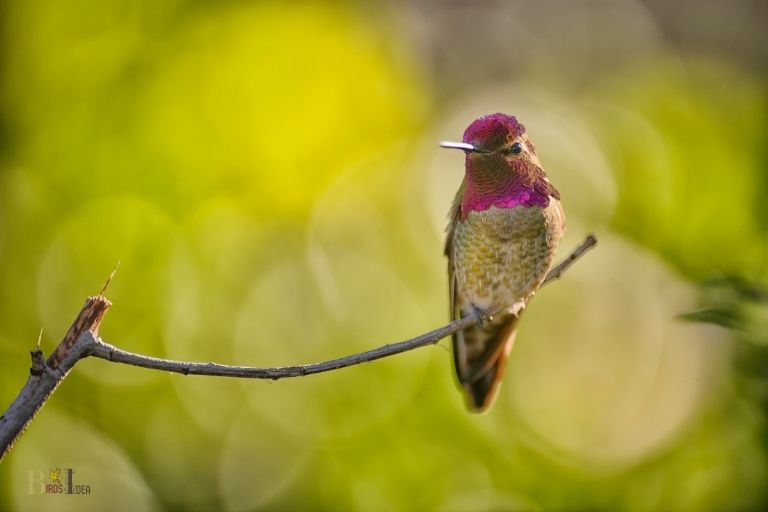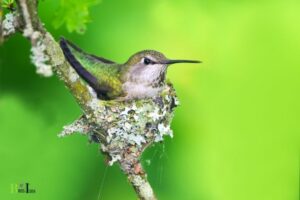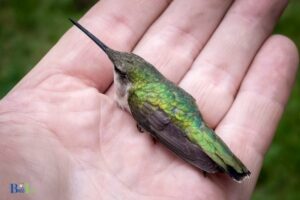How Big Do Hummingbirds Get? 3 to 5 inches in length
Hummingbirds typically reach an average size of 3 to 5 inches in length and weigh between 2 to 6 grams.
Hummingbirds are known for their small size, rapid wing flapping, and hovering capabilities. They are among the smallest bird species in the world.
The size of a hummingbird depends on the specific species, with over 300 species known to exist.
Hummingbirds are fascinating creatures, known for their remarkable agility and nimble flight patterns. They can beat their wings up to 80 times per second, allowing them to hover in place or fly backward with ease.
Although their tiny bodies seem fragile, these birds can fly at speeds of up to 34 miles per hour and cover long distances during migration.
Despite their small size, hummingbirds play a crucial role in pollination as they feed on nectar from various flowers.
Different Hummingbird Species size
| Species | Length (inches) | Weight (grams) |
|---|---|---|
| Bee Hummingbird | 2.2 | 1.6 |
| Ruby-throated Hummingbird | 3.0-3.7 | 2-6 |
| Anna’s Hummingbird | 3.9-4.3 | 4-4.6 |
| Black-chinned Hummingbird | 3.5 | 3-4 |
| Rufous Hummingbird | 3.1-3.5 | 2.5-4.5 |
| Violet-crowned Hummingbird | 3.9-4.3 | 4.2-4.9 |
| Calliope Hummingbird | 3.0-3.5 | 2-3.4 |
| Blue-throated Hummingbird | 4.3-5.1 | 7.4-9.9 |
Key Takeaway

Five Interesting Facts About Hummingbird Sizes
Understanding The Basics Of Hummingbirds
Hummingbirds are fascinating creatures that are well-known for their incredibly small size and unique ability to hover in the air. These little birds are not only beautiful, but they are also quite interesting.
Understanding the basics of hummingbirds can open up a whole new world of appreciation for these tiny creatures.
In this section, we will explore the key characteristics of hummingbirds and learn how big they can get.
Introduction To Hummingbirds And Their Characteristics
Hummingbirds are a family of birds known as trochilidae, and they are found throughout north, central, and south america.
Here are some of their unique characteristics:
- Hummingbirds are the smallest birds in the world. The smallest species, the bee hummingbird, is only 2.25 inches long and weighs less than a penny.
- They have incredibly fast wings. Hummingbirds can beat their wings up to 80 times per second, allowing them to hover in the air and fly backwards.
- Hummingbirds have a very high metabolism. They need to consume around half of their body weight in nectar each day to fuel their energy needs.
- Their bright feathers are iridescent and reflect light in different ways, creating stunning colors that change depending on the angle.
- Hummingbirds have a long, thin beak that they use to extract nectar from flowers and feeders.
Understanding How Big Hummingbirds Can Get
Despite their small size, hummingbirds come in a variety of shapes and sizes.
Here are some of the largest species of hummingbirds:
- The largest species of hummingbird is the giant hummingbird, which can grow up to 8 inches long and weighs up to 0.8 ounces.
- The second-largest species is the blue-throated hummingbird, which can grow up to 5.5 inches long and weighs up to 0.4 ounces.
- The third-largest species is the white-tailed hillstar, which can grow up to 5 inches long and weighs up to 0.4 ounces.
It is interesting to note that even the largest hummingbirds are still smaller than the average sparrow.
Despite their small size, hummingbirds are known for their incredible speed, maneuverability, and agility, making them one of the most fascinating creatures in the avian world,
Hummingbirds are truly amazing creatures that are worth appreciating. By understanding their unique characteristics and learning about how big they can get, you can gain a new perspective on these tiny birds.
Plus, with their iridescent feathers and fast wings, what’s not to love?
The Size Of Hummingbirds
Hummingbirds are known for their small size and unique characteristics.
Here is all you need to know about hummingbird sizes:
Size Comparison Of Hummingbirds With Other Birds
Hummingbirds are the smallest birds in the world. The size of their tiny bodies sets them apart from other bird species.
Here’s how hummingbirds measure up compared to other bird species:
- The smallest hummingbird, the bee hummingbird, is the size of a bee and weighs around two grams.
- The largest hummingbird, the giant hummingbird, is around 21-23 centimeters in length and weighs around 18-24 grams.
- Hummingbirds are smaller than sparrows, finches, and other common garden birds and can fit in the palm of your hand.
Comparison Of Different Species Of Hummingbirds And Their Sizes
There are over 300 different species of hummingbirds, and each one has its distinctly size.
Here are some of the most well-known hummingbird species and their sizes:
- The bee hummingbird is the smallest hummingbird species native to cuba and measures approximately 2.25 inches long.
- The anna’s hummingbird, found in western north america, is around 3.9 inches long.
- The ruby-throated hummingbird is one of the most common hummingbirds found in north america and is around 3 to 3.5 inches long.
- The sword-billed hummingbird, found in south america, is around 4.5 to 6.7 inches long, making it one of the largest hummingbird species.
The Average Length And Weight Of Hummingbirds
Hummingbirds have a unique body structure with tiny legs and wings, allowing them to hover in the air.
Here are the average lengths and weights of hummingbirds:
- The smallest hummingbird species, the bee hummingbird, is only 2.5 inches long and weighs just two grams.
- The average size for most hummingbirds is between 3-5 inches long and weighs between 2-20 grams.
- The largest hummingbird species, the giant hummingbird, can reach up to 10 inches long and weighs up to 24 grams.
Hummingbirds are unique and fascinating creatures with a size range that is truly awe-inspiring. Whether you’re a bird enthusiast or just curious about nature, learning more about hummingbirds is always a delight.
Factors Affecting The Size Of Hummingbirds
Hummingbirds are known for their small size, which varies according to several factors. These factors include genetics and species, climate and habitat, diet and nutrition, migration and breeding habits.
Here we will discuss each of these factors in further detail.
Genetics And Species
- The size of hummingbirds is influenced by their genetic disposition.
- Some species are naturally larger or smaller than others.
- The size of hummingbirds can be affected by their family tree.
Climate And Habitat
- The size of hummingbirds can be either limited or influenced by their habitat.
- Hummingbirds living in colder regions tend to be larger to preserve body heat.
- Larger hummingbirds may struggle in a hotter climate, leading to natural selection where a smaller size is favoured.
Diet And Nutrition
- Hummingbirds’ diet affects their size.
- A hummingbird that feeds on a more significant nectar concentration tends to be larger in size.
- A lack of proper nutrition can result in stunted growth and smaller sizes.
Migration And Breeding Habits
- Migration and breeding habits affect hummingbird sizes.
- The need for migratory flight requires a higher energy expenditure, which results in smaller hummingbirds.
- In contrast, those that migrate shorter distances stop less frequently or do not migrate, leading to larger sizes.
Hummingbirds are fascinating creatures that come in various sizes, influenced by many factors. From their genetic disposition and habitat to their diet, nutrition, and migratory habits, these factors play a significant role in determining a hummingbird’s size.
The World’S Largest Hummingbirds
Overview Of The Biggest Hummingbird Species
The world’s largest hummingbird species can reach up to 8 inches in length and weigh up to 0. 6 oz. These bird species are known for their distinctive coloring, which varies between species.
Here are some of the biggest hummingbird species ranked by size:
- The giant hummingbird
- The buff-winged starfrontlet
- The sword-billed hummingbird
- The white-tailed sabrewing
Comparison Of Their Characteristics, Including Size, Weight, And Beak Length
The largest hummingbird species are differentiated from others not only by their size but their various characteristics, including weight and beak length.
Here is a comparison of some of those characteristics:
- The giant hummingbird: This species can grow up to 8 inches long and weigh up to 0.6 oz, making it the largest hummingbird. The beak of the giant hummingbird can grow up to 1.3 inches long.
- The buff-winged starfrontlet: This species can reach 6.5 inches long and weigh up to 0.4 oz. Their beak is about 0.8 inches long.
- The sword-billed hummingbird: This species can grow up to 6.7 inches long and weigh up to 0.4 oz. Its beak is longer than its body, at 3.9 inches.
- The white-tailed sabrewing: This species can reach up to 6.9 inches long and weigh up to 0.3 oz. Its beak is around 1.2 inches long.
Distribution And Habitat
The largest hummingbird species can be found in different parts of south and central america, including mountain ranges and forests.
- The giant hummingbird: This species can be found in the andes mountains of south america, at elevations of up to 16,000 feet.
- The buff-winged starfrontlet: This species is found in the andean cloud forests of south america.
- The sword-billed hummingbird: These birds can be found in the andean mountains of south america, at elevations of up to 12,000 feet.
- The white-tailed sabrewing: This species can be found in the costa rica, panama, and parts of south america, in rainforests and cloud forests.
Overall, the world’s largest hummingbirds are unique birds with fascinating characteristics. Their distinctive appearance and behavior make them popular among bird enthusiasts and nature lovers alike.
FAQ on Hummingbirds Sizes
How Big Can A Hummingbird Get?
What Is The Average Size Of A Hummingbird?
Why Are Some Hummingbirds Larger Than Others?
Can Hummingbirds Grow Bigger In Captivity?
What Is The Largest Hummingbird Species?
Conclusion
Hummingbirds have been fascinating bird species since the beginning of time, bringing joy and excitement to bird lovers all over the world. The question of “how big do hummingbirds get” can be answered in various ways, depending on the specific species.
From the world’s smallest bird, the bee hummingbird, to the largest, the giant hummingbird, their sizes vary widely. Understanding the size differences between various hummingbird species brings a deeper appreciation for them and their incredible abilities. It is important for bird enthusiasts to continue to learn more about these fascinating creatures, their habitats, and behaviors.
Hummingbirds are a true wonder of the natural world, and we must do our part to protect and preserve them for generations to come. As we continue to explore the mysteries of hummingbirds, we can truly appreciate their unique beauty and significance in our world.






